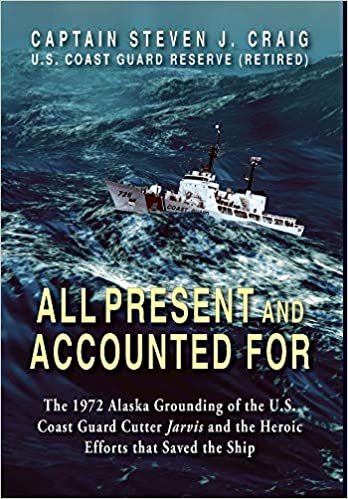Reviewed by Ellen A. Ahlness, PhD
All Present and Accounted For is a comprehensive, well-researched, and well-narrated case study in U.S. Coast Guard History. Throughout his narration of this disastrous grounding, Craig ensures the historical rendering is never sterile; instead, it maintains an eye to the human experience of a complicated event in U.S. Military history.
The book is divided into two parts, together comprising a total of twelve chapters. It also features an introduction, epilogue, final comments, and appendices. The inclusion of extensive supplemental information—including poetry, first-person accounts, images, informational visuals, and ship specifications of the USCGC Jarvis—maintains a fine balance between narrative storytelling and informational history. Craig is well situated to tell this story; he is a retired captain in the U.S. Coast Guard with nearly 40 years of service under his belt. Moreover, he has extensive experience responding to active and natural disasters, including the Hurricane Katrina and Ike responses, as well as the 2010 Haiti earthquake recovery planning. His academic, teaching, and speaking engagements further lend assurances to readers, even before the first page, that he is a writer well-versed in engaging audiences.
Driven by a long-standing desire to tell the story of the Jarvis, Craig conducted interviews with as many crew members as could be found. Demonstrating an incredibly valuable dedication to accuracy, he provides some of these comments and recollections verbatim in Appendix D. The appendices also give information on all the commanding officers of the Jarvis over time, linking the story of the 1972 crisis to the broader history of the Coast Guard. Whether a reader values historical rootedness or narrative storytelling, All Present and Accounted For does not disappoint.
The introduction begins by setting the stage with an overview of society and culture in America and the U.S. Coast Guard in the 1970s. What makes this particularly valuable is that it includes in-depth details of what everyday life looked like in the Navy and Coast Guard. This helps immerse readers in the scene, which is particularly beneficial for younger and non-military readers. For readers that are unfamiliar with the specifications and dynamics of a ship, footnotes are added to define concepts, explain ship layouts, and even detail Navy and Coast Guard customs. Each chapter starts like a diary, setting a place and time, whether a season, year, month, or day.
Part One discusses historical rescue missions off of Alaska and the inspirational actions of the ship’s namesake, Captain David H. Jarvis. This historical rendition examines the Alaska Relief Expedition led by then Lieutenant Jarvis from 1897 to 1898, for which he was honored with the naming of USCGC Jarvis. The ship, much like its namesake many years before, would be tested beyond normal human endurance.
Part Two first sets the stage for the Jarvis’s departure, introducing main characters and places in Alaska culminating with the Jarvis’s mission send off. By the end of Chapter 5, readers finally arrive at the point of disaster: the Jarvis running aground. Chapter 6 and those that follow dive into incredible detail of the grounding as well as the subsequent reaction and rescue of the Jarvis. Readers are seamlessly transitioned from the narrative of the grounding and response to quotes from participants, and even photographs of the Jarvis and its crew.
Even though the grounding of the Jarvis does not take place until the end of the fifth chapter, readers are never left with the sense that the story is being drawn out. Instead, all of the contextual information builds anticipation for the inevitable disaster. There is a notable transition in the book’s structure and layout from the moment the Jarvis runs aground. Before that point, time is measured in years, seasons, or months, but beginning in Chapter 6, time is detailed in increments of minutes, heightening the sense of urgency. By Chapter 10 the emergency has been dealt with, and it is time to return to port. A strong sense of the crew’s loyalty to one another and to the ship is palpable throughout Craig’s narration of the disaster response and the epilogue, which examines the later years of Jarvis and its Captain.
The last part of the main text details Craig’s sources, which include historical documents and oral histories. The thoroughness of Craig’s research credibly signals the text’s fidelity to true events. His final comment discusses his motivation for writing the book, which was not to second guess the findings of the board of investigation, nor to criticize the errors that led to the grounding (which he asserts are numerous). Instead, he sought to shed light on the individual efforts that contributed to the rescue of the vessel. Upon completing the book, readers are likely to find Craig’s main assertion quite compelling. When circumstances were at their bleakest, the crew did not panic but instead performed their duties admirably to save the ship. Consequently, the entire crew survived. Is that not the most important takeaway from such a disaster?
Ellen A. Ahlness, PhD, is a board member and writer for the educational nonprofit Education Maksad. Her past publications on military history and leadership appear in On Contested Shores, Ecologia Politica, and Considering Leadership Anew.
All Present and Accounted For: The 1972 Alaska Grounding of the U.S. Coast Guard Cutter Jarvis and the Heroic Efforts that Saved the Ship (Steven J. Craig, Hellgate Press, Ashland, OR, 2019).


